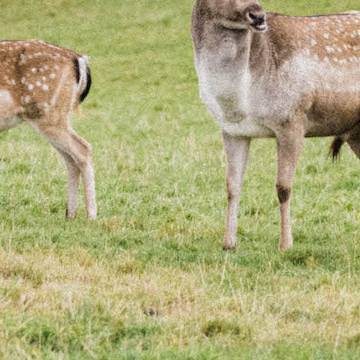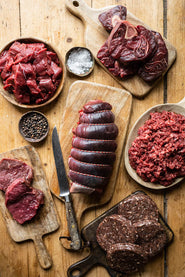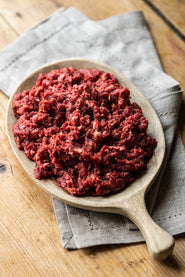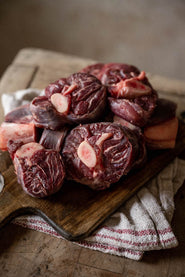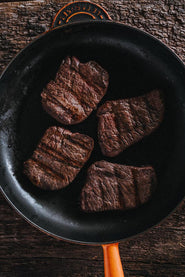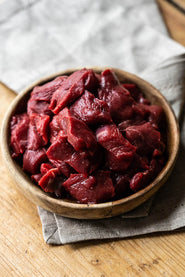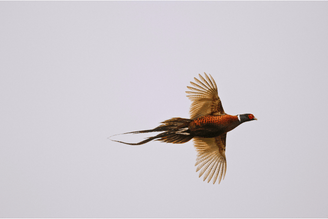Every time I drive through the imposing metal gates into this ancient Dartmoor estate, the view takes my breath away. A rural idyll balanced on the edge of Dartmoor, the long driveway winds its way through lush pasture, (today with a herd of woolly mule sheep munching away on the verdant grassland), with amber coloured pheasants crowing all around us, skittishly darting into the hedgerow for cover. A bubbling brook feeds into a tranquil lake just in front of the impressive 18th century manor house, its reflection punctuated by gusts of wind blowing across the surface. The estate rears Native Breed Devon Red Ruby cattle for Pipers Farm, as well as mutton, but today, it's the Venison and the ancient woodland they thrive in, that we are here to see. A mixture of fallow and red deer roam across the 3000 acre estate, preferring to take shelter amongst the ancient woodland, surrounded by grassy plains and rolling hills of Dartmoor.

It is here that we meet Mark, a conservation expert and encyclopaedia of all things deer. It is clear to see the passion and respect he has for this majestic animal, as well as the extensive knowledge he has of the local landscape.
The picturesque Dartmoor estate is is also home to some 2000 hectares of ancient woodland, which we are eager to explore further.
A short drive in the Land Rover follows the river deeper into the estate, where we pass under a canopy of green foliage, the very tips tinged with amber hues, clearly signalling the arrival of autumn.
This ancient woodland has been a part of the National Park since the 16th century, and is home to a plethora of flora and fauna which is crucial to maintaining thriving biodiversity in this timeless landscape. Lichen, moss and bracken carpet the trees and forest floor. Centuries old oak trees sheltering us from the rain drops which have steadily started to fall. The rain seems to accentuate the many shades of green in this verdant landscape, while the gentle pitter-patter of raindrops offers an atmospheric soundtrack to Mark’s explanations about this magnificent environment, and its relationship with the deer who graze amongst it.
Mark explains that wild deer are vital for helping trample vegetation into the soil. As they rush through the forest, their hooves break down rotting foliage from fallen leaves, and trample them into the earth, nourishing the top soil - in similar style to adding a bag of healthy compost to your flowerbed. With healthy top soil, plants thrive and germinate more easily, thus improving biodiversity of the woodland floor.
However, too many deer can have a really detrimental effect on the biodiversity of an area. Overpopulation will prevent any new saplings and plants from growing as an over population of deer means almost all young shoots, nuts and seeds are eaten by the deer, never getting chance to germinate in the soil. This is putting at risk many ancient woodlands, where old, gnarly trees are coming to the end of their time and for too many years replacement greenery has not sprung up in their shadow. When those trees eventually collapse to the ground, there will not be enough established trees to replace this loss, dramatically changing the landscape of large swathes of land.
It is this out of kilter activity which is worrying many conservation experts, such as Mark.
For too many years now local councils, landowners and establishments such as the National Trust and Devon Wild Life Trust haven't been able to come together with a clear and considered plan to manage wild landscapes. This has meant the deer population has simply moved from one parcel of land under another landowner's control to avoid being culled, making it much harder to maintain a healthy population of fit and well deer in the landscape.

Rewilding has become a popular notion in the last few years, and describes the concept where nature takes care of itself, with little human interference. However, rewilding would spell the death knell for this ancient copse, if we were to let the deer population run completely wild.
As an animal with no natural predators, the deer would decimate ageless landscapes such as ancient woodland; Mark estimates that the flourishing terrain we see before us today would disappear in as little as 40 years, without sensitive management.
“One way people can contribute to the conservation effort is by eating venison when it is in season” Mark explains.
"Our wild venison are derived from conservation projects focused solely on increasing biodiversity and the natural regeneration of our woodlands so as to create a multi-aged structure which will ensure future generations can enjoy the splendour of Autumn on Dartmoor through the preservation of this iconic landscape in a natural and balanced way."
All the deer are stalked and shot on the estate, before being hung for 12 days to achieve maximum depth of flavour. Wild venison has a beautifully rich and velvety flavour, which is perfect for slow cooking on a cold, autumn evening.

Mark also manages a herd of 150 fallow deer on the lush pastures next to Bovey Castle, a striking 19th century, Jacobean-style hotel with views over the rolling hills towards Chagford and beyond.
Here, the deer live in an environment that closely mimics their natural habitat. There is a mix of open ground and woodland set in acres of space for the deer to roam.
As this herd is managed, the animals are closely observed to ensure their welfare, and individuals tracked so they can be culled at a specific age to provide consistency in the venison produced.
Mark, along with his wife Victoria, use the park as a hub for education, to help both locals and visitors understand the importance of conservation.
A man with many strings to his bow, Mark and his wife Victoria also own a trio of beautiful Shire horses; Stuart, Rocky and Ben. Solid and dependable with kind eyes and a gentle soul, these placid animals take guests on a nostalgic trip down memory lane. The horses are used to taking guests on tours of the parkland, their very own Venison safari!

Adding more venison to your diet is a clear winner; not only is it gram for gram higher in protein and lower in cholesterol than any other meat, it is also vitally important for conserving our countryside.
We'll leave the last word to Mark...
"Local food doesn’t have to cost the earth; in fact it should conserve it, build relationships and support communities whose very way of life is our agricultural heritage. The environmental and social benefits of buying wild, local and real food, makes these choices incredible valuable to us all."
